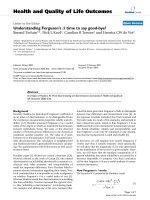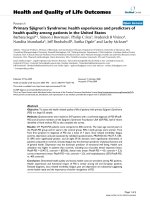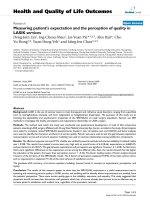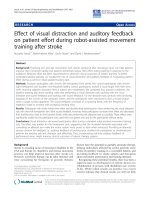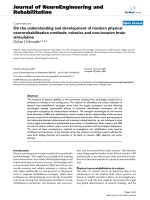Báo cáo hóa học: " On Minkowski’s inequality and its application" doc
Bạn đang xem bản rút gọn của tài liệu. Xem và tải ngay bản đầy đủ của tài liệu tại đây (221.76 KB, 5 trang )
RESEARCH Open Access
On Minkowski’s inequality and its application
Chang-Jian Zhao
1*
and Wing-Sum Cheung
2
* Correspondence: chjzhao@163.
com
1
Department of Mathematics,
China Jiliang University, Hangzhou
310018, China
Full list of author information is
available at the end of the article
Abstract
In the paper, we first give an improvement of Minkowski integral inequality. As an
application, we get new Brunn-Minkowski-type inequalities for dual mixed volumes.
2000 Mathematics Subject Classification: 52A30, 52A40, 26D15
Keywords: Minkowski?’?s inequality, H?ö?lder?’?s inequality, Brunn-Minkowski inequal-
ity, dual mixed volume
1 Improvement of Minkowski’s inequality
The well-known inequality due to Minkowski can be stated as follows ([1], pp. 19-20,
[2], p. 31]):
Theorem 1.1 Let f(x), g(x) ≥ 0 and p >1, then
(f (x)+g(x))
p
dx
1/p
≤
f (x)
p
dx
1/p
+
g(x)
p
dx
1/p
,
(1:1)
with equality if and only if f and g are proportional, and if p <1(p ≠ 0), then
(f (x)+g(x))
p
dx
1/p
≥
f (x)
p
dx
1/p
+
g(x)
p
dx
1/p
,
(1:2)
with equality if and only if f and g are proportional. For p <0, we assume that f(x), g
(x) >0.
An (almost) improvement of Minkowski’s inequality, for p Î ℝ\{0}, is obtained in the
following Theorem:
Theorem 1.2 Let f(x), g(x) ≥ 0 and p >0, or f(x), g(x) >0 and p <0. Let s, t Î ℝ\{0},
and s ≠ t. Then
(i) Let p, s, t Î ℝ be different, such that s, t>1 and (s - t)/(p - t) >1. Then
(f (x)+g(x))
p
dx ≤
f
s
(x)dx
1/s
+
g
s
(x)dx
1/s
s(p−t)/(s−t
)
×
f
t
(x)dx
1/t
+
g
t
(x)dx
1/t
t(s−p)/(s−t)
,
(1:3)
with equality if and only if f(x) and g(x) are constant, or 1/p =(1/s +1/t)/2 and f (x)
and g(x) are proportional.
(ii) Let p, s, t Î ℝ be different, such that s, t<1 and s, t ≠ 0, and (s - t)/(p - t) <1.
Then
Zhao and Cheung Journal of Inequalities and Applications 2011, 2011:71
/>© 2011 Zhao and Cheung; licensee Springer. This is an Ope n Access article distr ibuted under the terms of the Creative Commons
Attribution License (http://creativecomm ons.org/licenses/by/2.0), which permits unrestricted use, distribution, and reproductio n in
any medium, provided the original work is prop erly cited.
(f (x)+g(x))
p
dx ≥
f
s
(x)dx
1/s
+
g
s
(x)dx
1/s
s
(
p−t
)/(
s−t
)
×
f
t
(x)dx
1/t
+
g
t
(x)dx
1/t
t(s−p)/(s−t)
,
(1:4)
with equality if and only if f(x) and g(x) are constant, or 1/p =(1/s +1/t)/2 and f (x)
and g(x) are proportional.
Proof (i) We have (s - t)/(p - t) >1, and in view of
(f (x)+g(x))
p
dx =
[(f (x)+g(x))
s
]
(p−t)/(s−t)
· [(f(x)+g(x))
t
]
(s−p)/(s−t)
dx
.
By using Hölder’s inequality (see [1] o r [2]) with indices (s - t)/(p - t)and(s - t)/(s -
p), we have
(f (x)+g(x))
p
dx ≤
(f (x)+g(x))
s
dx
(p−t)/(s−t)
(f (x)+g(x))
t
dx
(s−p)/(s−t)
,
(1:5)
with equality if and only if (f(x)+g(x))
s(p - t)/(s - t)
and (f(x)+g(x))
t(s - p)/(s - t)
are pro-
portional, i.e., either f(x)+g(x) is constant or the exponents are equal, i.e., 1/p = (1/s +
1/t)/2.
On the other hand, by using Minkowski’sinequalityfors>1andt>1, respectively,
we obtain
(f (x)+g(x))
s
dx
1/s
≤
f
s
(x)dx
1/s
+
g
s
(x)dx
1/s
,
(1:6)
with equality if and only if f(x) and g(x) are proportional, and
(f (x)+g(x))
t
dx
1/t
≤
f
t
(x)dx
1/t
+
g
t
(x)dx
1/t
,
(1:7)
with equality if and only if f(x) and g(x) are proportional.
From (1.5), (1.6) and (1.7), (1.3) easily follows. From the equality conditions of (1.5),
(1.6) and (1.7), the case of equality stated in (i) follows.
(ii) We have (s - t)/(p - t) <1. Similar to the above proof, we have
(f (x)+g(x))
p
dx ≥
(f (x)+g(x))
s
dx
(p−t)/(s−t)
(f (x)+g(x))
t
dx
(s−p)/(s−t)
,
(1:8)
with equality if and only if either f(x)+g(x) is constant or 1/p = (1/s +1/t)/2.
On the other hand, in view of Minkowski’s inequality for the cases of 0 <s<1 and 0
<t<1,
(f (x)+g(x))
s
dx
1/s
≥
f (x)
s
dx
1/s
+
g(x)
s
dx
1/s
,
(1:9)
with equality if and only if f(x) and g(x) are proportional, and
(f (x)+g(x))
t
dx
1/t
≥
f (x)
t
dx
1/t
+
g(x)
t
dx
1/t
,
(1:10)
with equality if and only if f(x) and g(x) are proportional.
Zhao and Cheung Journal of Inequalities and Applications 2011, 2011:71
/>Page 2 of 5
The inequality (1.4) easily follows, with equality as stated in (ii). ■
Remark 1.3 For (i) of Theorem 1.2, for p>1, letting s = p + ε, t = p - ε, when p, s, t
are different, s, t>1, and (s - t)/(p - t) /2 >1, and letting ε ® 0, we get (1.1).
For (ii) of Theorem 1.2, for p<1 and p ≠ 0, s = p + ε, t = p +2ε, when p, s, t are dif-
ferent, s, t<1 and s, t ≠ 0, and (s - t)/(p - t) = 1/2 <1, and letting ε ® 0, we get (1.2).
2 An application
The setting for this paper is n-dimensional Euclid ean space ℝ
n
(n>2). Associated with
a compact subset K of ℝ
n
, which is star-shaped with respec t to the orig in, is its radial
function r(K, ·): S
n-1
® ℝ, defined for u Î S
n-1
,by
ρ(K, u)=Max{λ ≥ 0:λu ∈ K}.
If r(K, ·) is positive and continuous, K will be called a star body. Let
S
n
denote the
set of star bodies in ℝ
n
. Let
˜
δ
denote the radial Hausdorff metric, that is defined as fol-
lows: if
K
,
L ∈
S
n
, then
˜
δ
(
K, L
)
= |ρ
K
− ρ
L
|
∞
(see e.g. [3]).
If
K
1
, , K
r
∈ S
n
and l
1
, ,l
r
Î ℝ, then the radial Minkowski linear combination,
λ
1
K
1
˜+ ··· ˜+λ
r
K
r
, is defined by Lutwak (see [4]), as
λ
1
K
1
˜+ ··· ˜+λ
r
K
r
=
{
λ
1
x
1
˜+ ··· ˜+λ
r
x
r
: x
i
∈ K
i
}
.Here,
λ
1
x
1
˜+ ··· ˜+λ
r
x
r
equals l
1
x
1
+ +l
r
x
r
if x1, , x
r
belong to a linear 1-subspace of ℝ
n
, and is 0 else. It has the following
important property, for
K
,
L ∈
S
n
and l, μ ≥ 0
ρ
(
λK ˜+μL, ·
)
= λρ
(
K, ·
)
+ μρ
(
L, ·
)
(2:1)
For
K
1
, , K
r
∈
S
n
and l
1
, , l
r
≥ 0,thevolumeoftheradialMinkowskilinear
combination
λ
1
K
1
˜+ ··· ˜+λ
r
K
r
is a homogeneous nth-degree polynomial in the l
i
,
V
(λ
1
K
1
˜+ ··· ˜+λ
r
K
r
)=
˜
V
i
1
, ,i
n
λ
i
1
···λ
i
n
(2:2)
where the sum is taken over al l n-tuples (i
1
, , i
n
) whose entries are positive integers
not exceeding r. If we require the coefficients of the polynomial in (2.2) to be sym-
metric in their argument, then they are uniquely determined. The coefficient
˜
V
i
1
, ,i
n
is
positive and depends on ly on the star bodies
K
i
1
, , K
i
n
. It is written as
˜
V(K
i
1
, , K
i
n
)
and is called the dual mixed volume of
K
i
1
, ,
K
i
n
.IfK
1
= = K
n-i
= K, K
n-i+1
=
= K
n
= L, the dual mixed volumes are written as
˜
V
i
(
K, L
)
. I n particular, for B the unit
ball about o,
˜
V
i
(
K, B
)
is written as
˜
W
i
(
K
)
(see [5]).
For
K
i
∈ S
n
, the dual mixed volumes were given by Lutwak (see [6]), as
˜
V
(K
1
, , K
n
)=
1
n
S
n
−1
ρ(K
1
, u) ρ(K
n
, u)dS(u)
,
(2:3)
For
K
,
L ∈
S
n
and i Î ℝ,theith dual mixed volume of K and L,
˜
V
i
(
K, L
)
, is defined
by,
˜
V
i
(K, L)=
1
n
S
n−1
ρ(K, u)
n−i
ρ(L, u)
i
dS(u)
.
(2:4)
Zhao and Cheung Journal of Inequalities and Applications 2011, 2011:71
/>Page 3 of 5
From (2.4), taking in consideration r(B, u) = 1, if
K
∈ S
n
, and i Î ℝ
˜
W
i
(K)=
1
n
S
n−1
ρ(K, u)
n−i
dS(u)
.
(2:5)
The well-known Brunn-Minkowski-type inequality for dual mixed volumes can be
stated as follows [6]:
Theorem 2.1 Let
K
,
L ∈ S
n
, and i < n - 1. Then,
˜
W
i
(
K ˜+L
)
1/(n−i)
≤
˜
W
i
(
K
)
1/(n−i)
+
˜
W
i
(
L
)
1/(n−i)
,
(2:6)
with equality if and only if K and L are dilates.
The inequality is reversed for i > n - 1 and i ≠ n.
In the following, we establish new Brunn-Minkowski-type inequalities for dual mixed
volumes.
Theorem 2.2 Let
K
,
L ∈ S
n
and i, j, k Î ℝ.
(i) Let i, j, k Î ℝ be different, such that j, k<n-1, and (j-k)/(i-k) >1. Then
˜
W
i
(K ˜+L) ≤
˜
W
j
(K)
1/(n−j)
+
˜
W
j
(L)
1/(n−j)
(n−j)(k−i)/(k−j
)
×
˜
W
k
(K)
1/(n−k)
+
˜
W
k
(L)
1/(n−k)
(n−k)(i−j)/(k−j)
,
(2:7)
with equality if and only if K and L are balls, or 1/(n-i)=[1/(n-j)+1/(n - k)]/2,
and K and L are dilates.
(ii) Let i, j, k Î ℝ be different, such that j, k>n-1 and j, k ≠ n , and (j - k)/(i - k) <1.
Then
˜
W
i
(K ˜+L) ≥
˜
W
j
(K)
1/(n−j)
+
˜
W
j
(L)
1/(n−j)
(n−j)(k−i)/(k−j
)
˜
W
k
(K)
1/(n−k)
+
˜
W
k
(L)
1/(n−k)
(n−k)(i−j)/(k−j)
,
(2:8)
with equality if and only if K and L are balls, or 1/(n-i)=[1/(n-j)+1/(n-k)]/2,
and K and L are dilates
Proof We begin with the proof of (i). From (2.1), (2.5) and (1.3), we have
˜
W
i
(K ˜+L)=
1
n
S
n−1
ρ(K ˜+L, u)
n−i
dS(u)=
1
n
S
n−1
(ρ( K, u)+ρ(L, u))
n−i
dS(u)
≤
1
n
ρ(K, u)
n−j
dx
1/(n−j)
+
ρ(L, u)
n−j
dx
1/(n−j)
(n−j)(k−i)/(k−j)
×
ρ(K, u)
n−k
dx
1/(n−k)
+
ρ(L, u)
n−k
dx
1/(n−k)
(n−k)(i−j)/(k−j)
=
˜
W
j
(K)
1/(n−j)
+
˜
W
j
(L)
1/(n−j)
(n−j)(k−i)/(k−j)
˜
W
k
(K)
1/(n−k)
+
˜
W
k
(L)
1/(n−k)
(n−k)(i−j)/(k−j)
,
with equality if and only if as stated in (i).
Similarly, case (ii) of Theorem 2.2 easily follows. ■
Remark 2.3 For (i) of Theorem 2.2, for n - i>1, letting s = n - i + ε, t = n - i - ε,
when i, j, k are different, n - j, n - k>1, and (k - j)/(k - i)=2>1, and letting ε ® 0,
we get the following result: Let
K
,
L ∈ S
n
, and i<n- 1. Then,
Zhao and Cheung Journal of Inequalities and Applications 2011, 2011:71
/>Page 4 of 5
˜
W
i
(
K ˜+L
)
1/(n−i)
≤
˜
W
i
(
K
)
1/(n−i)
+
˜
W
i
(
L
)
1/(n−i)
,
with equality if and only if K and L are dilates.
This is just the well-known inequality (2.6) in Theorem 2.1.
For (ii) of Theorem 2.2, for n - i<1 and n - i ≠ 0, s = n - i + ε, t = n - i +2ε, when i,
j, k are different, n - j, n - k<1 and n - j, n - k ≠ 0, and (k - j)/(k - i) = 1/2 <1, and let-
ting ε ® 0, we get the following result:
Let
K
,
L ∈ S
n
, and i<n- 1 and i ≠ n. Then,
˜
W
i
(
K ˜+L
)
1/(n−i)
≥
˜
W
i
(
K
)
1/(n−i)
+
˜
W
i
(
L
)
1/(n−i)
,
with equality if and only if K and L are dilates.
This is just an reversed form of inequality (2.6).
Acknowledgements
The authors wish to thank the referee for his many excellent suggestions for improving the original manuscript.
This Research is supported by National Natural Science Foundation of China(10971205) and in part by a HKU URC
grant.
Author details
1
Department of Mathematics, China Jiliang University, Hangzhou 310018, China
2
Department of Mathematics, The
University of Hong Kong, Pokfulam Road, Hong Kong
Authors’ contributions
C-JZ and W-SC jointly contributed to the main results Theorems 1.2 and 2.2, Both authors read and approved the final
manuscript.
Competing interests
The authors declare that they have no competing interests.
Received: 23 February 2011 Accepted: 27 September 2011 Published: 27 September 2011
References
1. Beckenbach, EF, Bellman, R: Inequalities. Springer, Berlin-Göttingen (1961)
2. Hardy, GH, Littlewood, JE, Pólya, G: Inequalities. Cambridge University Press, Cambridge (1934)
3. Schneider, R: Convex Bodies: The Brunn-Minkowski Theory. Cambridge University Press, Cambridge (1993)
4. Lutwak, E: Intersection bodies and dual mixed volumes. Adv Math. 71, 232–261 (1988). doi:10.1016/0001-8708(88)90077-1
5. Gardner, RJ: Geometric Tomography. Cambridge University Press, New York (1996)
6. Lutwak, E: Dual mixed volumes. Pacific J Math. 58, 531–538 (1975)
doi:10.1186/1029-242X-2011-71
Cite this article as: Zhao and Cheung: On Minkowski’s inequality and its application. Journal of Inequalities and
Applications 2011 2011:71.
Submit your manuscript to a
journal and benefi t from:
7 Convenient online submission
7 Rigorous peer review
7 Immediate publication on acceptance
7 Open access: articles freely available online
7 High visibility within the fi eld
7 Retaining the copyright to your article
Submit your next manuscript at 7 springeropen.com
Zhao and Cheung Journal of Inequalities and Applications 2011, 2011:71
/>Page 5 of 5



